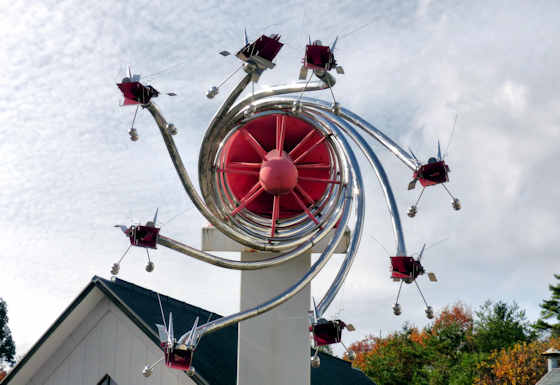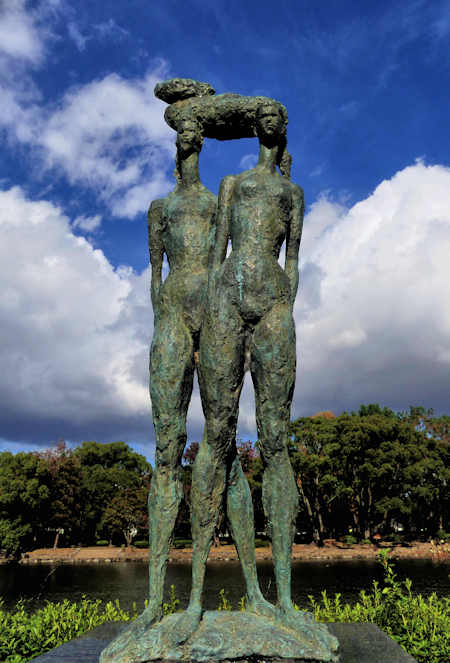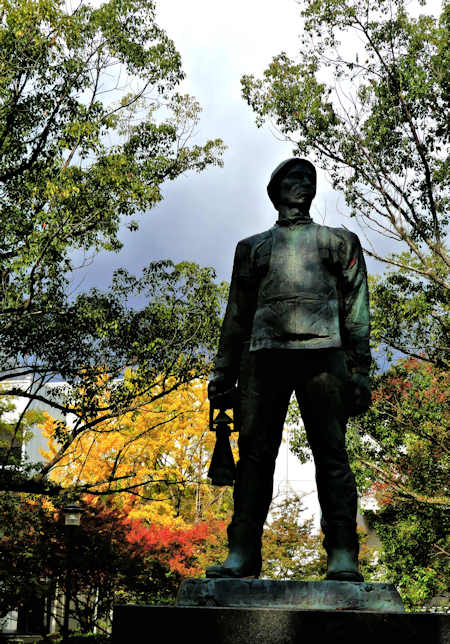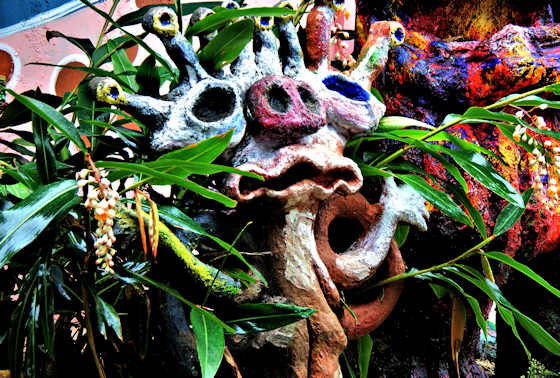Installed originally as part of a 2014 arts festival, the statue can only be seen by hiking a mountain trail after driving a very narrow mountain road.
Sunday, December 1, 2024
Another Time XX by Antony Gormley
Friday, July 28, 2023
Yamata no Orochi
Monday, January 16, 2023
Tadao Koga Sculpture Forest
Tadao Koga Sculpture Forest
Within the grounds of what was Saga Castle, adjacent to the reconstructed palace, are the Saga Prefectural Museum and the Saga Prefectural Art Museum. Between them and the moat is the Tadao Koga Sculpture Forest.
Tadao Koga (1903-1979) was a Japanese sculptor born in Saga and many of his works are on display in this outdoor exhibit. I suspect there is more of his work inside the art museum but I did not go in to find out.
The works on display are larger-than-life bronzes that reminded me of socialist art of the mid-20th century.
Other than a statue of Saigo Takemori in Kirishima, he does not seem to have produced anything of note, though he was chairman of the Japan Sculpture Society.
The top piece is Hoshin, 1960. The second is Spring Cloud, 1963, the third is Gamecock & Man, 1958. The fourth is Limit, 1965. The fifth is Grow Next Generation, 1956. The sixth is Factory Night Watchman from 1938, and the final photo is Three Fishermen from 1954.
It's a nice, free, public art space that is worth a look if you are visiting the castle.
Thursday, February 17, 2022
Surreal & Psychedelic Shisa of Ishigaki Island
石垣島
Friday, April 16, 2021
Some Art at Horakuji Temple
Buddhist temples in Japan, like temples, shrines, and churches all over the world, are often repositories of a lot of art. Some temples have a little in the grounds, ornamenting the architecture, and inside on the aktars, etc. Some however are rich in artworks amd can be like visiting a museum or gallery.
Thursday, April 30, 2020
Anger From the Bottom by Beat Takeshi
As I was climbing up towards the first mountain temple on the Shodoshima Pilgrimage I spied ahead of me what I guessed was a kind of shrine. When I got to it I was faced with a stainless steel figure with big red eyes and an axe embedded in its skull.
Anger From the Bottom is a sculpture by "Beat" Takeshi Kitano and Keniji Yanobe, originally produced for the Setouchi Art Triennale that takes place in the area. It is one of the artworks that is now permanently on display.
Originally there was no roof over it, and the statue was below ground only rising up for 5 minutes every hour. Takeshi is famous in japan as a comedian and TV presenter, but internationally he is known as a film-maker. The unexpected and surprising is a large part of why I enjoy my walks around rural Japan......
Monday, July 22, 2019
Isshiki Kazari Komainu
Isshiki Kazari is a unique form of folk art that origjnated in Hirata up in Izumo. The essence of the art is that sculptures are made out of everyday objects. Nothing too original in that, but its the further rules that make it so. The objects cannot be broken, drilled, nor glued. Afterwards the sculpture can be disaseembled and the objects returned to use.
Ceramics are the prime material, but not the only material for Isshiki Kazari. The sculptures were/are made as offerings for the local shrine, but nowadays as part of the matsuri they hold a competition to choose the best each year.
I was taken by these komainu in a tableau of the shrine. The competition entries are temporarily on display around the old part of town, although there are many other more permanent examples that are not part of the competition
Monday, June 17, 2019
Ikuchijima Island-Wide Art Museum
On the second day of my walk from Honshu to Shikoku along the Shimanami Kaido I left Kosanji Temple and started walking down the west coast of the island. On the beach looking westward was this statue, a Jizo I think.
A little further, set on a rock in the water was an unusual modern sculpture, "Wings of the Waves" by Susumu Shingu, one of 17 modern sculptures located around the island in what they call the Island-Wide Art Museum
Sunset Beach runs down the coast almost to the Tatara Bridge which crosses over to Omishima.
At the southern end of the beach another couple of sculptures. In the foreground is "Calm Time-Red form / Inclination by Keiji Uematsu, and in the background "Clairvoyance" by Shin Matsunaga.
Art can take many forms, but this old bus is not part of the Island-Wide Art Museum.
Tuesday, April 30, 2019
The Weird & Wonderful Folk Statues of Takanabe Daishi
On a hill overlooking Takanabe on the Miyazaki coast are a strange collection of large and small statues. Some of them are Buddhist deities, and some are Kami.
They were the creation of a local man who was concerned about the spirits of the deceased in a series on ancient burial mounds nearby. He employed a sculptor to carve a set of statues, and then after having watched him at work he set about creating his own unique statues and devoted the rest of his life to it.
They are quite primitive and unsophisticated in their execution, but therein lies their charm. At times looking like Native American totem poles, at other like the Easter Island statues, but most of all they are child-like.
For more photos and a lot more information please check out this longer article I wrote































































